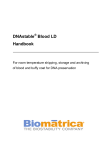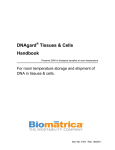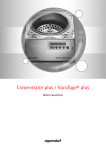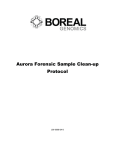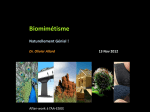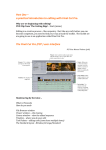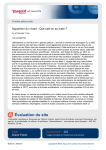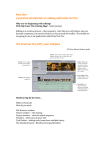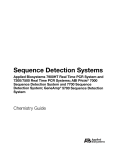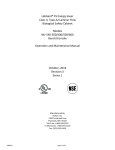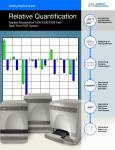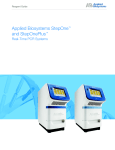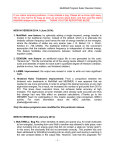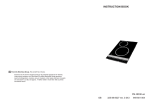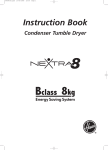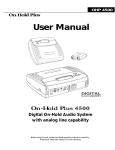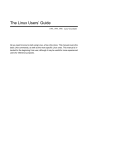Download Users Guide - Biomatrica
Transcript
RNAstable®/ RNAstable® LD Handbook Preserve and store RNA samples at room temperature Protocols for Sample Stabilization, Sample Recovery and Downstream Applications Contents Product Formats................................................................................ 3 Introduction ....................................................................................... 4 Principles and Procedures................................................................. 5 Material needed by user .................................................................... 6 Storage ............................................................................................. 6 Applications....................................................................................... 7 Important Notes................................................................................. 7 Protocol: Sample preparation ........................................................... 9 Protocol: Sample drying and storage................................................ 9 Protocol: Sample recovery ............................................................. 11 Protocol: Downstream applications ................................................ 12 Troubleshooting Guide .................................................................... 13 Appendix A: UV spectrophotometry with RNAstable ...................... 15 Appendix B: Quantitative PCR using samples stored in RNAstable ........................................................................................................ 17 Quality Control ................................................................................ 19 Product Use Limitations .................................................................. 19 Warranty and Satisfaction Guarantee.............................................. 19 Literature Citation ............................................................................ 19 Safety Information ........................................................................... 19 Technical Assistance....................................................................... 21 Page 2 of 21 / Item No. 10001 / Rev. 05/2013 Product Formats RNAstable® Format* Catalog Number # • 93221-001 • 93220-001 Individual tubes • 90222-001 • 93220-001 96-well plate Description Usage • 1.5 ml screw cap microfuge tubes made of durable polypropylene Individual samples • 96-well plate made of durable polypropylene • Standard footprint • Hinged lid provides additional sample protection • AeraSeal Sealing Films Low & High Through-put labs *All formats are supplied with barcodes. For information on labels with RFID (Radio Frequency Identification Device), please contact us. * All formats identical capacity, ≤100µg RNA per tube or well RNAstable®LD Format 2ml Tube 10 ml bottle (5) 10ml bottles Catalog Number # • 53201-013 • 52201-013 • 52201-033 Description Usage • (1) 2ml tube • (1) 10ml bottle • (5) 10ml bottles Automation friendly Liquid Stabilizer Accessories for Long-term Sample Storage >1 month Moisture Barrier Bags: Sample Pouches with Desiccant Packs, Catalog number 14001-007. Sold in sets of 10. Dry Storage Cabinets: • Dry Storage Cabinet, Small with racks, Catalog number: 95905-058. External dimensions: 8.75"x 10.75"x11.65". Maximum capacity of (84) multiwell plates. Includes (1) desiccant pack. • Dry Storage Cabinet, Medium with racks, Catalog number: 95904-158. External dimensions: 25"x 10.75"x 11.65". Maximum capacity of (294) multiwell plates. Includes (5) internal adjustable racks, hygrometer, (1) desiccant pack. • Dry Storage Cabinet, Large with racks, Catalog number: 95905-158. External dimensions: 25"x 10.75"x 23". Maximum capacity of (588) multi-well plates. Includes (10) internal adjustable racks, hygrometer, (2) desiccant packs. Page 3 of 21 / Item No. 10001 / Rev. 05/2013 Introduction Biomatrica offers innovative technologies for stabilizing biological samples at room temperature. We have developed a high performing platform technology designed for use in protecting complex biological samples and assays. Sample preservation is achieved without degradation, thus enabling labs to decrease their reliance on freezers and drastically reduce shipping costs. RNAstable is a unique storage medium that preserves RNA samples at room temperature. RNAstable allows for long-term stabilization of RNA samples with easy sample recovery by simply adding water. RNAstable is based on the natural principles of anhydrobiosis (“life without water”), a biological mechanism employed by organisms such as tardigrades and brine shrimp that enables their survival while dry for up to 120 years. Anhydrobiotic organisms protect their DNA, RNA, proteins, membranes and cellular systems, and can be revived by rehydration. By exploiting these unique characteristics, RNAstable preserves RNA dry at ambient temperatures. RNAstable works by forming a glass-like shell, securely “shrink-wrapping” RNA samples and protecting against degradation. RNAstable enables you to store RNA samples for months and allows you to use samples directly in downstream applications without the need for further purification. Samples are stabilized without cold storage and there is no sample degradation through freeze/thawing. This results in increased reproducibility and reliability. Since samples are stored at room temperature, precious freezer space is freed up. The cost for shipping RNA samples is drastically reduced, as samples secured with RNAstable can be transported at ambient temperatures, even for extended transit periods. Using RNAstable, you can completely recover your RNA samples by simple rehydration - just add water. Rehydrated samples are ready for immediate use, without the need for further purification. Downstream applications using recovered samples that have been tested include: • Quantitative RT-PCR Page 4 of 21 / Item No. 10001 / Rev. 05/2013 • • • • Bioanalyzer and microarray analysis End-point PCR and gel analysis cDNA synthesis Reverse transcription Additional applications are certainly feasible as we have found no significant difference in those applications tested. Visit www.biomatrica.com for further details on the complete line of room temperature sample stabilization products that Biomatrica offers. Principles and Procedures RNAstable is a mixture of thermo-stable dissolvable compounds that stabilize RNA at room temperature and prevents degradation. The matrix formulation is based upon the natural principles of anhydrobiosis and synthetic chemistry. Meaning “life without water,” anhydrobiosis is a biological mechanism employed by some multicellular organisms that enables their survival in a dry state for periods of more than 120 years (Crowe et al., Ann. Rev. Physiol. 1998. 60:73); during these extended dry periods, proteins, DNA, RNA, membranes, and cellular systems are protected and can be revived by rehydration. Based on the unique thermo-stable properties of Biomatrica’s proprietary formulation, RNAstable forms a protective seal around RNA as it dries, effectively “shrink-wrapping” the sample in a protective coating. Drying can occur at ambient temperatures either through airdrying (for example in a biosafety hood) or with a vacuum concentrator (i.e. SpeedVac®). Stored dry at ambient temperatures, the protected RNA can be safely stored for more than 21 months. Biomatrica accelerated aging study demonstrate safe stored for up to 12 years at room temperature and RNAstable can even protect RNA kept at 50°C for up to 21 months. Please note that we recommend storing prepared samples protected from moisture in either a dry storage cabinet or a heat-sealed, moisture-barrier bag along with a silica gel desiccant packet. Samples can be recovered through simple rehydration and are ready for immediate use, without the need for further purification. Page 5 of 21 / Item No. 10001 / Rev. 05/2013 Material needed by user • RNAse-free pipet tips • RNAse-free RNA • SpeedVac or Vacufuge Plus Storage RNAstable products and kits should be stored dry in their original unopened packaging at ambient laboratory temperatures (i.e. room temperature at 15-25°C or 59-77°F) until ready for use. RNAstable LD tubes or bottles should be stored at 4°C in their original unopened packaging before use. The RNAstable products are supplied in moisture-barrier foil bags along with a desiccant pack. An extra bag and desiccant set are also included. Additional Sample Pouches/Desiccant Packs are sold as sets of twelve at www.biomatrica.com, catalog number 14001-007. The sample pouch allows for dry storage, even in uncontrolled humidity environments, and serves as an alternative to storage in a dry storage cabinet. The moisture-barrier foil bag should be opened just before use. Samples stabilized for storage should be inserted along with a desiccant packet into the pouch and heat-sealed. Alternatively, store dried samples in a dry storage cabinet at room temperature (15-25˚C). Unused products should be placed back in their original packaging, zip-lock-sealed and stored at room temperature in a clean, dry environment. For optimal results when shipping samples stabilized in RNAstable tubes or 96-well plates, please utilize the moisture barrier foil bag (sample pouch) along with a desiccant packet and heat seal to insure a dry environment. Note: Please visit www.biomatrica.com for ordering information on dry storage cabinets customized for the RNAstable product or extra sample pouches, or desiccant packs. Page 6 of 21 / Item No. 10001 / Rev. 05/2013 Applications Sample Type: RNAstable has been used extensively for room temperature dry storage of purified total RNA and poly(A) mRNA. Assay Type RNA stored in RNAstable is ready for immediate use in the following applications: • • • • Quantitative RT-PCR Bioanalyzer analysis Agarose gel electrophoresis Reverse Transcription (RT) • • • RT-PCR Microarray analysis cDNA synthesis Shipping: RNAstable provides the ideal format for transport and shipping of samples at ambient temperatures. Individual tubes or plates can be slipped into moisture barrier foil bags along with a desiccant pack, heat-sealed and shipped conveniently without the need for cold packs, dry ice or Styrofoam® packing, thus greatly reducing shipping costs. Fluctuating temperatures or delays during transport do not affect samples protected in RNAstable. (Additional Sample Pouches/Desiccant Packs are available for purchase as sets of 10, catalog number 14001-007. Visit www.biomatrica.com for complete product listings and details.) Important Notes Please take a few moments to read this handbook carefully before beginning the sample stabilization step for dry storage of RNA at room temperature. For optimal protection and sample recovery: RNA should be purified of any contaminating RNase activity. Page 7 of 21 / Item No. 10001 / Rev. 05/2013 Sample Application and Drying Prior to applying to wells or tubes containing RNAstable, samples should be resuspended in DEPC-treated water. Sample must then be dried completely for optimal protection and stability during room temperature storage. Sample volumes of up to 100 µl of water can be applied directly into an RNAstable tube or well and dried with a vacuum concentrator (e.g. using a SpeedVac or Vacufuge Plus). For optimal results, do not exceed 100 µg of total RNA per tube or well in a maximum volume of 100 µl water. RNAstable LD Add 20µl of RNAstable LD to stabilize 10pg to 100µg of the RNA sample (up to 100µl) directly into each tube or well. Gently mix by pipetting up and down to mix. Proceed with same drying conditions as recommended for RNAstable. RNAstable Add RNA to RNAstable Allow sample to dry completely in a laminar flowhood or speedVac RNA is dried and protected in RNAstable Place dried RNA samples in a foiled sealed bag with dessicant or in a dry cabinet Sample Storage Store dried samples in either (a) a dry storage cabinet at room temperature (15-25°C or 59-77°F) (b) a heat-sealed, moisture-barrier bag along with a silica gel desiccant packet. Recover sample in minutes, Just add water RNAstable products are supplied in moisture-barrier foil bags along with a desiccant packet. Extra Sample Pouches/Desiccant Packs are sold as sets of ten, catalog number 14001-007. Visit www.biomatrica.com for complete product listings and details.) Sample Recovery To recover samples stored in RNAstable, just add water. An aliquot of DEPC-treated nuclease-free water is supplied with the kit. Samples are then ready for immediate use in downstream Page 8 of 21 / Item No. 10001 / Rev. 05/2013 applications. It is not necessary to further purify rehydrated samples. Aqueous solutions such as TE buffer (10 mM Tris, 1 mM EDTA), PCR reaction buffers, and reverse transcription buffers are also compatible with the recovery of samples from RNAstable. Protocol: Sample preparation This protocol is designed for the preparation of purified RNA for storage in RNAstable. Types of RNA Suitable types of RNA that can be stored in RNAstable include purified total RNA from cells or tissues, and poly(A) mRNA. Purification Techniques Most standard molecular biology techniques and/or commercially available kits are compatible with RNAstable storage. For optimal results, RNA samples should be RNase free. Purified RNA that is RNase-free should be resuspended in DEPCtreated water prior to application into RNAstable. Determining yield The concentration of the RNA sample should be determined prior to sample application into RNAstable. Although not essential, applying a known amount of RNA into RNAstable for storage can facilitate sample retrieval and subsequent applications. For optimal protection in RNAstable, do not apply more than a total of 100 µg of RNA per well or tube in a maximum volume of 100 µl water. Samples must be completely dried before storage at room temperature to prevent degradation; we recommend drying samples with a vacuum concentrator (e.g. SpeedVac or Vacufuge Plus). Protocol: Sample drying and storage RNAstable protects RNA samples at room temperature. Each tube or plate contains RNAstable provided as a coating at the bottom of the tube or well, which protects picogram to microgram amounts of RNA. This medium is completely dissolvable and ensures total sample Page 9 of 21 / Item No. 10001 / Rev. 05/2013 recovery. The sample must then be completely dried for maximum protection and stability for storage at ambient temperatures. Note: In the event you want to determine the RNA concentration at a later date using a spectrophotometer, you should keep an unused RNAstable well or tube to generate a blank. See pg. 15 for further instructions. The sample must be RNAse-free. Procedure 1. Determine the amount of purified RNA (µg/ml) in the sample and calculate the amount to be applied into RNAstable wells or tubes. RNA should be resuspended in DEPC-treated water prior to application on RNAstable. 2. Open cap on the tube or remove the seal from the 96-well plate. Gently add up to 100 µl [≤100 µg] of the RNA sample directly into the center of each tube or well containing RNAstable. For optimal sample protection and recovery, the final volume of the sample applied to each well should be ≤20 µl for airdrying; do not exceed applying 100 µl water per tube or well. 3. Mix the sample thoroughly with gentle pipetting (avoid forming air bubbles). 4. For convenient air-drying of volumes ≤20 µl, leave the tube or 96-well plate open overnight in laminar flow hood. For volumes ≥20 µl , or for accelerated drying of all, please use a vacuum concentrator (i.e. SpeedVac or Vacufuge Plus) without heat to ensure complete sample drying. Recommended drying times are provided in Table 1 (pg. 11). (Optional): To avoid cross contamination Simply apply the Breathe EASIER membrane to an open tube or the AeraSeal Sealing Film to a plate. The membrane pores allow air to flow in and are small enough to keep RNases out. Page 10 of 21 / Item No. 10001 / Rev. 05/2013 When samples are dry, remove the membrane. Close the cap to microfuge tubes and apply adhesive sheet to plates. Note: Drying should occur at ambient laboratory temperatures (15°C–25°C) (see pg. 5). Table 1. Drying times with SpeedVac / Vacufuge Plus (no heat) Sample Volume Times 10 - 20 µl 30 minutes >20 - 30 µl 1 hr >30 - 100 µl 1.5 hrs 5. For sample storage, close tube or well after sample drying and store at room temperature (15–25°C) in either a dry storage cabinet or a sealed moisture barrier foil bag. After complete sample drying, plates should be re-sealed with aluminum foil seals (provided in kit). Tubes should be tightly closed using screw cap. RNAstable is sensitive to temperature and humidity, therefore it is critical to maintain stored samples at room temperature (15-25°C) in an environment protected from moisture. The recommended humidity level is ≤ 30% relative humidity. Protocol: Sample recovery RNA stored in RNAstable can be recovered by the addition of water or aqueous buffer. Samples are ready for downstream applications without the need for further purification. Procedure 1. Add 10-100 µl of DEPC-treated water (supplied in kit) or aqueous buffer directly to the dried sample in RNAstable. Individual wells in a plate can be opened by puncturing the aluminum foil seal with a pipette tip or razorblade. Page 11 of 21 / Item No. 10001 / Rev. 05/2013 Samples may be rehydrated directly with aqueous buffers used for downstream applications such as reverse transcription buffers, PCR buffers, etc. Note: Samples can be easily concentrated at this step if an appropriate amount of water or buffer is used to rehydrate a known amount of stored RNA. 2. Incubate at room temperature for 15 min to allow complete rehydration. After 15 minutes, mix the sample by gently pipetting up and down to resuspend the sample. Avoid forming bubbles. 3. The rehydrated sample is now ready for use directly in downstream applications. To determine RNA concentration and recovery yield, see Appendix A (pg. 15) for directions on how to perform UV spectrophotometry (i.e. A260 reading) using samples stored in RNAstable. 4. Store unused rehydrated samples at 4°C or room temperature for up to 3 days. Samples can also be stored frozen (-20°C or -80°C) for longer time periods. Rehydrated samples in water containing RNAstable can be re-dried without loss of efficient sample stabilization. Repeating this process more than 3 times is not recommended. Protocol: Downstream applications Rehydrated RNAstable samples do not require further purification for the majority of molecular biology applications, and can be used directly without interference or inhibition in downstream applications. See pg. 4 for complete list of suitable applications. For further results and examples, refer to www.biomatrica.com under Application Notes. Page 12 of 21 / Item No. 10001 / Rev. 05/2013 RT-PCR and quantitative RT-PCR analysis using TaqMan or SYBR® Green reagents should be performed using guidelines as detailed in Appendix B (pg. 17). If necessary, samples can be purified using column purification technology from commercially available kits. Troubleshooting Guide Dry storage of RNA in RNAstable is extremely effective for storage of samples at room temperature, between 15-25°C for long-term storage and temperature variations of up to 50°C. RNAstable is a dry storage technology and samples must be protected from moisture. Stabilized samples should be placed in either (a) a dry storage cabinet or (b) a heat-sealed, moisture-barrier bag along with a silica gel desiccant packet to ensure a permanently controlled environment. High humidity will hydrate RNAstable, resulting in sample degradation. The following troubleshooting guide may be helpful in solving any problems that arise. Scientists at Biomatrica’s Technical Service Department are available to answer questions about the information and protocols in this handbook or general molecular biology applications (see pg. 19 for contact information). Situation Comment Suggestion RNA is currently in TE buffer. RNA must be in water prior to application into RNAstable. Precipitate RNA and resuspend in DEPC-treated water. Added too much water or TE buffer for rehydration. Addition of too much water or TE buffer does not harm RNA or RNAstable. Place hydrated sample in laminar flow hood and allow to partially or fully dry. Use partially dried sample or rehydrate fully dried sample in correct volume. Unused RNAstable color is faded or has a slight change in coloration. Fading or color change of RNAstable does not affect protective properties. Proceed with sample application, drying, storage and rehydration as directed. Low yield of rehydrated RNA sample. Purified RNA safely stored in RNAstable does not degrade unless it is contaminated by considerable quantities of RNases. If recommended sample preparation, drying, and storage procedures are followed, degradation from contaminating RNases will be • Prior to sample application, record the quantity of RNA applied to RNAstable for future reference. • Make sure sample is applied to center of well or tube containing RNAstable and not on the sides of the vessel. • Identical samples can be Page 13 of 21 / Item No. 10001 / Rev. 05/2013 Situation Comment Suggestion inhibited. rehydrated separately and the contents can be combined. • Ensure samples are RNase free prior to storage. Page 14 of 21 / Item No. 10001 / Rev. 05/2013 Appendix A: UV spectrophotometry / Nanodrop with RNAstable Situation Comment Suggestion RNAstable turned pink after addition of RNA sample. RNAstable contains a color indicator (pH sensitive). The color change will not inhibit protection. Proceed with protocol. Cold storage of dried samples at (4° or -20° or -80°C). Cold storage of samples in RNAstable does not interfere with product performance. Samples can be placed at room temperature. The desired volume for rehydration is outside of the recommended minimum or maximum volume. • It is necessary to remain within the recommended 10-100 µl rehydration volume for optimal results. • Lower volumes can inhibit complete rehydration of RNA and decrease recovery. • Larger volumes may result in over-flow of wells in the 96well format, and impede proper mixing. Samples can be rehydrated in the recommended volumes and then brought up to the desired volume once samples are mixed. Transfer to a separate vessel may be necessary. RNA is contaminated. Only purified RNA that is free of RNase should be used for longterm storage in RNAstable. Rehydrated RNA can be purified using organic extraction (phenol: chloroform:IAA) or column purification technology from commercially available kits. RNA appears degraded after rehydration. Dry storage of RNA in RNAstable is dependent on low humidity environments (i.e. ≤30%). All samples should be stored either inside sealed moisture barrier bags or in a dry storage cabinet and kept at room temperature. Reduced or increased rehydration times. Minimum rehydration time (15 min) is important for full recovery of stored RNA. Maximum rehydration time should not exceed 1 hour. A 5 min rehydration time with mixing can be used; however, there may be a slight reduction in sample recovery. Rehydration of 15 min is recommended to ensure complete sample recovery. Keep plate or tube covered with lid during rehydration to avoid contamination and evaporation. Less volume is recovered from well than was initially added for rehydration. Rehydration of the dissolvable matrix may cause a reduction in sample volume recovery. This is especially noticeable for smaller volumes (i.e. <20 µl) • Minimal loss of recovered sample volume does not affect the stability or performance of RNA or RNAstable in downstream applications. A 10% loss in volume can be included for adjustment (e.g. add 11 µl of water to ensure recovery of 10 µl of rehydrated sample). Page 15 of 21 / Item No. 10001 / Rev. 05/2013 The absorbance of UV light (260 nm) can be used to determine the concentration of rehydrated RNAstable samples. Procedure 1. Prepare sample and blank The UV spectrophotometer or Nanodrop must be blanked against an aliquot of RNAstable for accurate A260 readings. Sample: Rehydrate well or tube containing sample stored in RNAstable in a final volume large enough to obtain an accurate absorbance reading (volume is dependent on cuvette size). The absorbance will be accurate up to a reading of 2, at which point sample dilution may be necessary to obtain an accurate A260 reading. Blank: Blank the spectrophotometer with an RNAstable-only reference sample. Rehydrate an unused tube or well containing only RNAstable (i.e. no RNA) using the same volumes (including dilutions) as was performed for sample preparation. 2. Reference the Spectrophotometer / Nanodrop against RNAstable. Blank the spectrophotometer / nanodrop using the RNAstableonly reference sample. 3. Determine A260 reading of sample. 4. Calculate concentration of sample. The nucleic acid concentration for a standard cuvette with 1 cm path length can be calculated as follows: Conc. (µg/ml) = (A260 reading) (40 µg/ml) (dilution factor) Possible sources of error in determining RNA concentration can include contamination with proteins and organic molecules, such as phenol and ethidium bromide. If this is the case, the RNA can be purified prior to absorbance reading (e.g. put through a spin column). An alternative method, such as gel visualization, can also be used. Page 16 of 21 / Item No. 10001 / Rev. 05/2013 Appendix B: Quantitative PCR using samples stored in RNAstable Samples recovered from dry storage in RNAstable can be used directly in real-time quantitative PCR (QPCR) reactions without further purification. For optimal results we recommend the following dilutions of rehydrated samples when using either TaqMan® or SYBR® Green technology. TaqMan® Technology A 1:5 final dilution is recommended. Samples should be rehydrated in a volume appropriate for 50 µl QPCR reaction (total final volume) prior to following manufacturer’s instructions. Example TaqMan® One-Step RT-PCR Master Mix Reagents Kit 1. Human 293T total RNA was diluted to 100 ng/µl in DEPCtreated water and 5 µl was added to wells containing RNAstable that were then dried, sealed and stored at room temperature for 6 weeks inside a moisture barrier foil bag. 2. Samples were rehydrated with 50 µl of water for 15 min at room temperature and mixed gently prior to use. 3. For each QPCR reaction, 10 µl of rehydrated sample was added to 40 µl of QPCR master mix containing: 25 µl 2X Master Mix without UNG (ABI) 1.25 µl 40X Multiscribe and RNase Inhibitor Mix 1 µl 10 µM forward primer 1 µl 10 µM reverse primer 1.25 µl 10 µM probe 10.5 µl water +10 µl rehydrated RNA sample 50 µl total volume Page 17 of 21 / Item No. 10001 / Rev. 05/2013 4. A Thermal Cycler (ABI 7300 Real Time PCR System) was used with the following cycling conditions: Reverse transcription: 48°C for 30 min AmpliTaq gold activation: 95°C for 10 min PCR (40 cycles): 95°C for 15 sec 60°C for 1 min 5. The predicted concentration of RNA as determined by QPCR was found to be equivalent between the test and control samples (+/-10%). A slope of -3.1 to -3.6 and an R2 value of 0.99 are considered acceptable. SYBR® Green Technology A final 1:20 dilution is recommended for RNAstable samples used in QPCR with SYBR Green reagents. Example SYBR® Green reaction 1. Human 293T total RNA was diluted to 100 ng/µl in DEPCtreated water and 5 µl was added to wells containing RNAstable that were then dried, sealed and stored at room temperature for 6 weeks inside a moisture barrier foil bag. 2. Samples were rehydrated with 25 µl of water for 15 min at room temperature prior to use. 3. For each QPCR reaction, 2.5 µl of rehydrated sample was added to 50 µl of QPCR master mix following manufacturer’s instructions 4. Use thermal cycling reaction conditions as recommended by the manufacturer. Page 18 of 21 / Item No. 10001 / Rev. 05/2013 Quality Control Every manufacturing production lot of RNAstable is quality control tested for contamination and functional performance. All products are tested against predetermined specifications to ensure consistent product quality. Product Use Limitations RNAstable technology is specifically designed for the stabilization of purified RNA samples. No claim or representation is intended for their use on any other biological materials. RNAstable products are for research use only and are not intended for use in diagnostic procedures. For optimal performance, products must be used and stored according to manufacturer’s guidelines. Optimal protection of RNA in RNAstable occurs when samples are prepared and stored at room temperature and protected from moisture. Please refer to “Sample drying and storage” (pg. 9) for details on preparing and storing RNA under relative humidity conditions exceeding 30%. Warranty and Satisfaction Guarantee Biomatrica, Inc. guarantees the performance of all products in the manner described in our product literature. The purchaser must determine the suitability of the product for a particular use. Should any of our products fail to perform satisfactorily due to any reason other than misuse, Biomatrica will replace it free of charge or refund the purchase price, at your request. Biomatrica reserves the right to change, alter, or modify any product to enhance its performance and design. Contact Biomatrica if a product does not meet your expectations. Warranties of merchantability or fitness for a particular purpose are expressly disclaimed. Biomatrica’s liability shall not exceed the purchase price of the product. Biomatrica shall have no liability for indirect, consequential, or incidental loss or damages from the use, results of use, or inability to use its products. A copy of Biomatrica’s full limited warranty statement is available at www.biomatrica.com or upon request. Literature Citation When a procedure utilizing this product is described in a manuscript for publication, kindly refer to it as RNAstable from Biomatrica, Inc. Safety Information When working with chemicals, always wear a suitable lab coat, disposable gloves, and protective eyewear. For more information, please consult appropriate material safety data sheets (MSDS, available online at www.biomatrica.com, in PDF format). Page 19 of 21 / Item No. 10001 / Rev. 05/2013 Page 20 of 21 / Item No. 10001 / Rev. 05/2013 Technical Assistance Biomatrica, Inc. takes pride in providing efficient quality technical support. Biomatrica’s Technical Service Department is staffed by experienced scientists with extensive practical and theoretical expertise in molecular biology and the use of Biomatrica’s biostability and storage products. Please contact Biomatrica directly with any questions regarding RNAstable technology, product use, or general matters. Technical Service Department: Phone: USA (866) DRY-MTRX or (866) 379-6879 Web: www.biomatrica.com Email: [email protected] 5627 Oberlin Drive, Suite 120 San Diego, CA 92121 Page 21 of 21 / Item No. 10001 / Rev. 05/2013





















